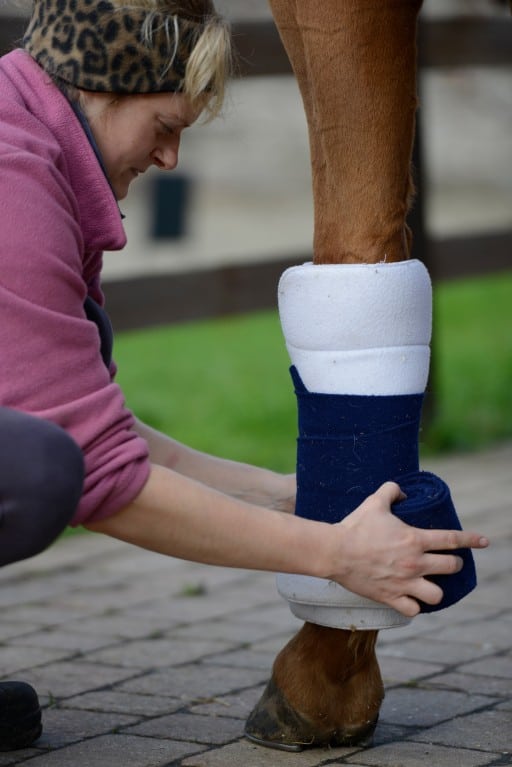What you need before you start, plus step-by-step guides to applying the most common types of bandages that will get your horse care skills off on a roll…

You never know when it might be necessary to bandage your horse, so make sure you are well-prepared and know how to do it well.
Top tips…
Always bandage legs in pairs – ie, two fronts or two backs – so the uninjured leg has some support and is less likely to be damaged or strained if your horse favours this one.
Obviously a bandage needs to be tight enough to stay up, but too tight will do more harm then good. If it’s safe to do so, slide your finger in the top to check.
What you need
Before you start, make sure you have all the required gear to hand
Stable
Gamgee, stable bandage
Knee and hock
Sterile dressing, padding bandage (eg, Soffban or cotton wool), cohesive bandage
(eg, Vetrap), round-ended scissors.
Poultice
Ready-made poultice (eg, Animalintex, gamgee or cotton wool), cohesive bandage (eg, Vetrap), waterproof tape (eg, duck tape), round-ended scissors.
Pressure pad
Clean padding, such as a wad of gamgee.
Get ready to unroll!
It is a good idea to develop your bandaging techniques when you have a little time on your hands and aren’t under any pressure.
If the time comes when you do need to bandage your horse for emergency or theraputic reasons, the last thing you will want to be worrying about are your bandaging skills!
Here are some step-by-by-step guides to common types of bandages.
Type of bandage:
Stable bandage

Stable bandages can help prevent swelling, protect injuries and provide support and warmth to your horse’s legs.
You never know when it might be necessary to stable bandage your horse, so make sure you are well-prepared and know how to do it well.
What you need
Gamgee, stable bandage
Step-by-step:
Stable bandage
1 Wrap the gamgee around your horse’s leg so that it covers just above the knee, right down to the coronet band. Make sure the edge of the gamgee is on the outside of your horse’s leg so that it’s putting pressure on the tendons.
2 Starting just under the knee, wrap the bandage around the leg facing front to back on the outside.
3 The bandage should go to just under the fetlock, leaving a little gamgee visible below, before wrapping back up to the knee.
4 Aim to finish the bandage below the knee, but finishing it on the side of the cannon bone is okay, too.
5 Do up the Velcro so the edge is on the outside of the leg and won’t be rubbed undone.
Type of bandage:
Hock bandage
A hock bandage can protect and support the hock. Special care must be taken not to apply pressure to the point of the hock.
When applying a knee or hock bandage, put on a stable bandage, too, as this will help to prevent it from slipping down.
Step-by-step:
Hock bandage
1 Place a sterile dressing on top of the wound.
2 Wrap a padding bandage over this and around the leg above the hock, to hold the dressing in place.
3 Bandage around the hock in a figure of eight, without covering the point of hock.
4 When you get near the end of the bandage, lightly cover the point of hock with a single layer.
5 Apply a cohesive bandage over this, to hold it in place. Begin at the top, circling the leg twice to secure.
6 Again, continue to bandage over the hock in a figure of eight, without covering the point of hock.
7 When you’ve nearly run out of bandage, lightly cover the point of hock with a single layer.
8 Pinch thebandage over the point of hock and carefully cut it.
Type of bandage:
Knee bandage
 A knee bandage can protect and support the knee. Special care must be taken not to apply pressure to the accessory bone, the hard lump at the back of the knee.
A knee bandage can protect and support the knee. Special care must be taken not to apply pressure to the accessory bone, the hard lump at the back of the knee.
With any bandage, pressure should be even throughout and they should be checked and changed twice a day – unless your vet says otherwise.
Step-by-step:
Knee bandage
1 Apply a trerile dressing on top of the wound.
2. Wrap a padding bandage over the dressing and above the knee, to hold it in place.
3 Continue to bandage in a figure of eight over the knee, without covering the accessory bone – the hard lump at the back of the knee.
4 When you’re near the end of the bandage, lightly cover the accessory bone with a single layer.
5 Secure a cohesive bandage. Begin at the top, wrapping the bandage around the leg a couple of times.
6 Continue to bandage in a figure of eight over the knee, as in point three.
7 Avoid bandaging over the accessory bone until the final layer, and then just lay the bandage over it, so as not to apply too much pressure.
8 Carefully pinch the bandage over the accessory bone.
9 Using blunt end scissors, carefully cut it off, to eliminate any pressure.
















